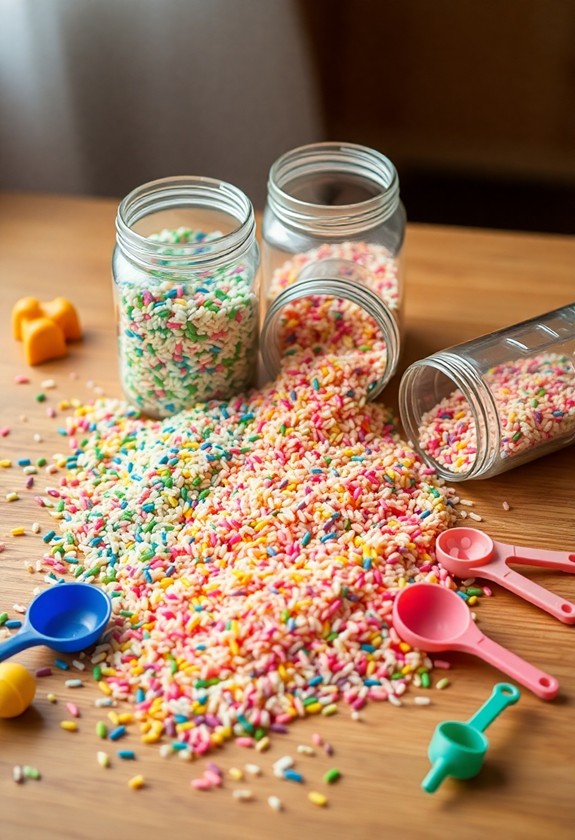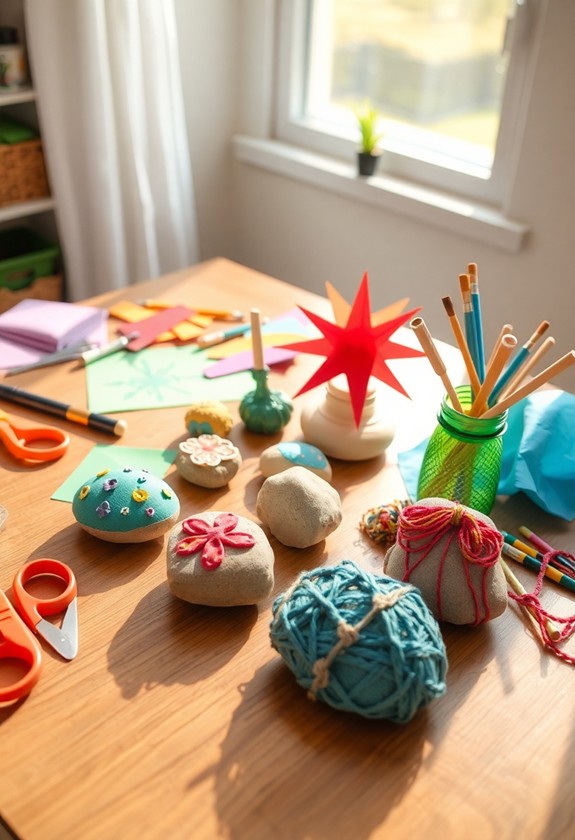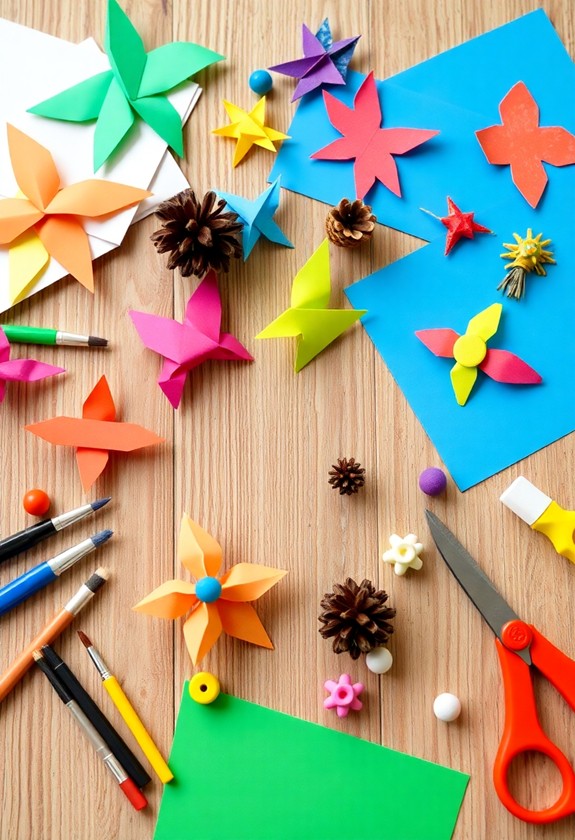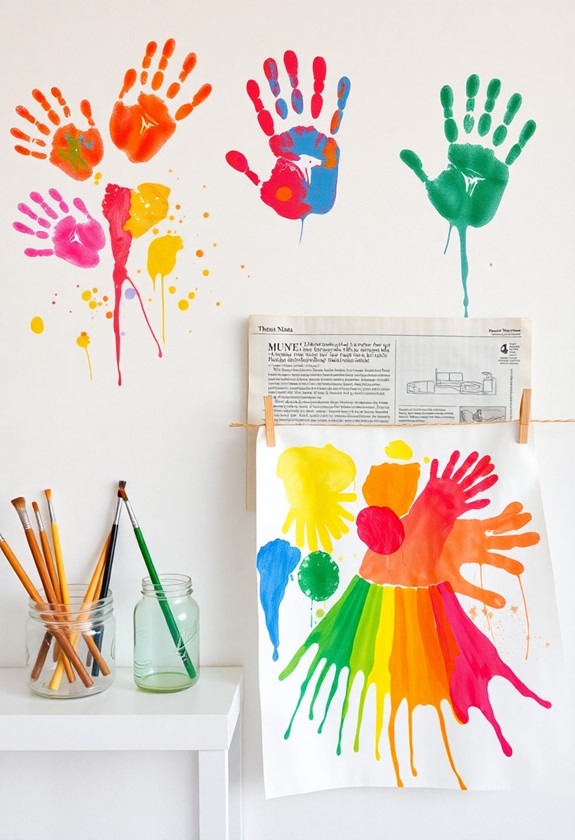Looking for cheap, fun sensory activities for your toddler? You're in luck! Try these three exciting options: First, create a colorful rice sensory bin – it's a tactile wonderland! Simply add food coloring to uncooked rice and watch your little one investigate. Next, whip up some homemade playdough using everyday ingredients. It's safe, squishy, and oh-so-fun to mold! Finally, grab some brushes and let your toddler "paint" with water outdoors. It's mess-free and magical as their creations disappear in the sun. These activities are not just budget-friendly but also fantastic for developing fine motor skills and sparking imagination. Ready to plunge into a world of sensory excitement?
Creative Highlights
- Rice sensory bins provide colorful exploration and fine motor skill development using inexpensive household materials.
- Homemade playdough offers customizable, safe sensory play while encouraging creativity and imagination.
- Water painting adventures allow mess-free artistic expression and cooling fun on hot days with minimal supplies.
- These activities engage multiple senses, promoting cognitive and physical development in toddlers.
- All three activities are cost-effective, using readily available materials and requiring minimal preparation time.
Rice Sensory Bin
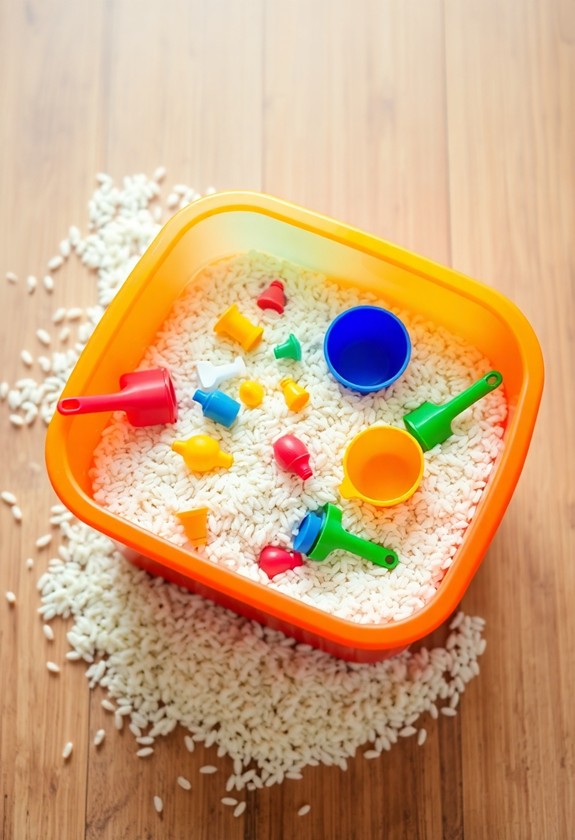
A colorful rice bin offers endless sensory exploration for toddlers. It's super easy to set up, and your little one will be mesmerized for hours! Here's how to create this rice-tastic adventure:
- Grab a large, shallow container
- Pour in 5-10 pounds of uncooked rice
- Add food coloring for a rainbow effect
- Toss in fun tools like:
- Scoops and cups
- Plastic animals
- Small cars or trucks
Let your toddler dig in and get rice-diculous! They'll love scooping, pouring, and burying treasures. This activity is a sensory bonanza that helps develop fine motor skills and imagination. Plus, it's a great way to introduce concepts like colors, counting, and pretend play. Just be prepared for a bit of mess – but that's half the fun! Remember to supervise and keep rice away from little mouths.
Homemade Playdough Creations
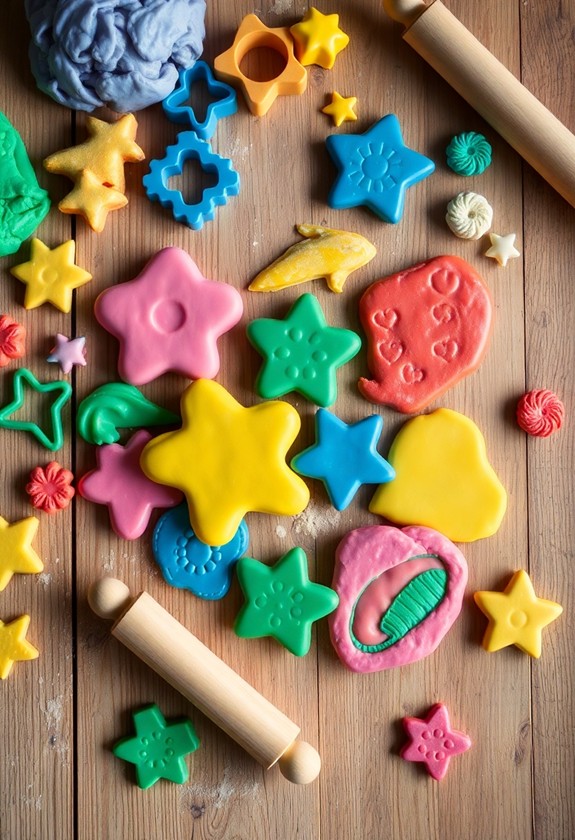
Moving from rice to another tactile sensation, homemade playdough offers a squishier experience for tiny hands. It's super easy to make and provides hours of fun! You'll love watching your little one's imagination soar as they mold and shape their creations. Plus, it's a great way to develop fine motor skills and creativity.
Here's why homemade playdough is amazing:
- It's cheap and uses ingredients you already have!
- You can customize colors and scents for extra sensory fun.
- It's safe if accidentally ingested (unlike store-bought versions).
To make your own, mix flour, salt, water, and food coloring. Knead until smooth, and voila! You've got a fantastic sensory tool. Let your toddler squish, roll, and shape to their heart's content. They'll be having a ball as they learn!
Water Painting Adventures
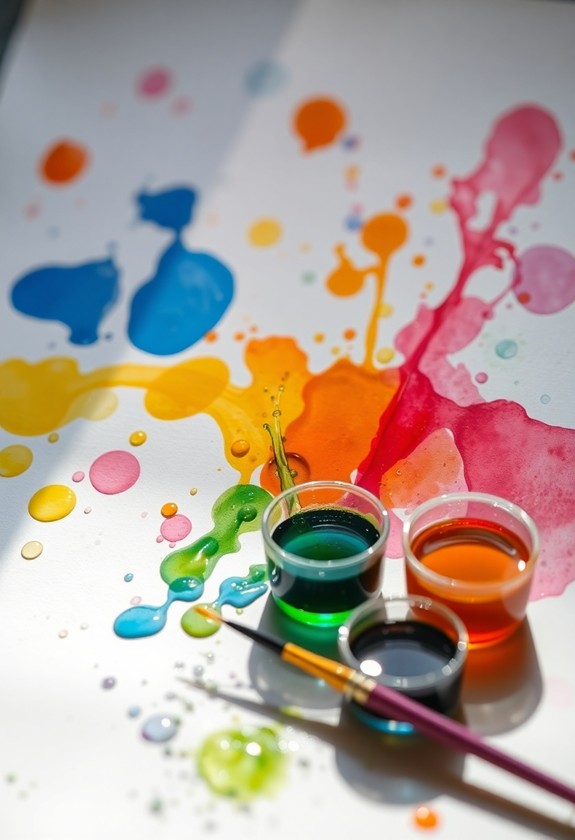
Ever wondered how to keep your toddler entertained without spending a dime? Search no more than water painting adventures! This activity is a splash hit with little ones and couldn't be simpler. It's a mess-free design that allows toddlers to engage in creative expression without stress over potential mess, making it perfect for on-the-go fun.
Here's what you'll need:
- A bucket of water
- Paintbrushes (or sponges)
- A sunny day
Let your tot loose on the sidewalk, fence, or side of the house with their "magical" water brush. Watch as they create masterpieces that disappear like magic! It's a no-mess, no-stress way to encourage creativity and fine motor skills.
Spice things up by:
- Adding food coloring for colorful creations
- Using different-sized brushes for varied effects
- Drawing shapes for them to trace
This wet and wild activity will keep your little Picasso occupied for hours! Plus, it's a great way to beat the heat on scorching summer days.
Curious Little Questions
How Can I Make Sensory Activities Safe for Toddlers With Allergies?
Safety first, sensory fun second! When creating allergy-safe activities for your little one, you've got to be a detective. Here's how:
- Know their triggers: Make a list of no-no ingredients
- Read labels like a pro: Check everything!
- Go natural: Use allergy-friendly materials (think rice, pasta, or water)
- Clean up: Wash hands and surfaces before and after
- Supervise: Keep a watchful eye on your investigator
What Age Is Appropriate to Start Introducing Sensory Activities?
Imagine your little one's eyes lighting up like sparklers as they immerse themselves in a world of sensory wonder! You can start introducing sensory activities as early as 6 months old. It's never too soon to engage those tiny senses! By 1 year, your tot's ready for more complex play. Remember, every child develops differently, so follow their lead. Start simple and gradually increase complexity. Sensory play is a fantastic way to boost development, and it's so much fun! Let the exploration begin!
How Do I Clean up Messy Sensory Activities Easily?
Cleaning up messy sensory activities can be a breeze! Here are some quick tips:
- Prep your space: Lay down a plastic tablecloth or old sheet first.
- Contain the chaos: Use large trays or bins to keep materials in one spot.
- Quick clean-up crew: Have wet wipes, towels, and a dustpan handy.
- Rinse and repeat: For water activities, set up near a sink or bathtub.
- Make it fun: Turn clean-up into a game – who can pick up the most pieces?
You'll be squeaky clean in no time!
Can Sensory Activities Help With Developmental Delays in Toddlers?
Sensory activities can be a game-changer for toddlers with developmental delays. They're like a workout for your little one's brain! These fun, hands-on experiences help stimulate their senses and boost essential skills. You'll see improvements in:
- Fine motor skills
- Language development
- Cognitive abilities
- Social interaction
Plus, they're a blast! Whether it's squishing play-doh or investigating a texture board, you're giving your child a sensory-sational advantage. So, get ready to plunge into the world of touchy-feely, smelly-yummy, sight-tastic activities!
Are There Any Sensory Activities Specifically Designed for Calming Overactive Toddlers?
Ever wondered how to calm your little tornado? You're in luck! There are plenty of sensory activities designed to soothe overactive toddlers. Try these:
- Squeezing playdough or stress balls
- Swinging in a hammock or blanket swing
- Creating a cozy corner with soft blankets and pillows
- Using a weighted lap pad or vest
- Blowing bubbles or pinwheels
These activities engage their senses and help them focus. It's like hitting the "chill button" on your energetic kiddo! Remember, every child's different, so experiment to find what works best.

